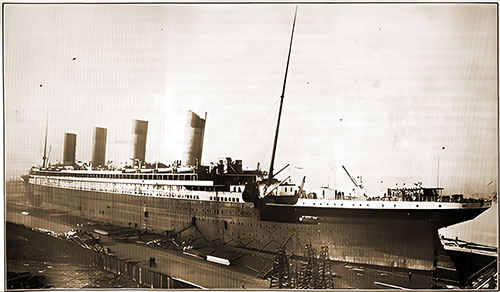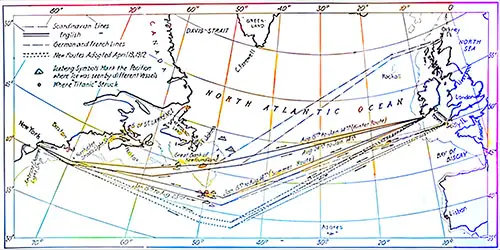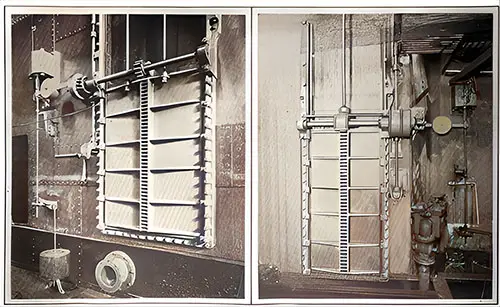Titanic: Marine Engineering, Disaster Impact, and Safety Reforms - Marine Review Images
📌 Explore rare technical images of Titanic from Marine Review Magazine (May 1912), including its dry dock inspection, iceberg collision diagram, lifeboat images, and the Senate inquiry into the disaster. A vital resource for maritime history and ship safety reforms.
Titanic Images for officials of companies engaged in shipbuilding, ship operation, and terminals, lighterage, storage, etc.
Titanic Images - Marine Review 🚢📸
Overview
This article, published in Marine Review (May 1912), provides a technical and investigative perspective on the RMS Titanic’s construction, sinking, and aftermath. Unlike other collections focusing on luxury and passenger life, this review is tailored toward shipbuilders, maritime officials, and those involved in ocean travel logistics.
This makes it an exceptional resource for:
🔹 Teachers and students studying the mechanical and engineering aspects of Titanic.
🔹 Historians and maritime enthusiasts analyzing the structural vulnerabilities of Titanic and how they contributed to the disaster.
🔹 Genealogists and researchers interested in the Senate inquiry and ship safety reforms after the tragedy.
By including rare images of Titanic in dry dock, engineering schematics, and key moments from the disaster’s aftermath, this article is a crucial primary source for studying maritime history.

The Titanic in Dry Dock at Belfast, Taken Just Before She Left for Southampton to Proceed on Her Maiden Trip. Marine News, May 1912. GGA Image ID # 10ac9015c5

This Picture Depicts What in All Probability Happened to the Titanic. She Struck a Massive, Projecting Underwater Shelf of an Iceberg, Ripping Open Her Bilges on the Starboard Side from Near the Bow to Practically Amidships. The. Energy of the Blow is Estimated at 1,161,000 Foot-Tons. © Scientific American. Marine News (May 1912) p. 157. GGA Image ID # 10acc78937

Chart of the North Atlantic, Showing the New Summer Routes for Steamers. The Turning Points are Indicated by Small Open Circles. Prepared from information furnished by hydrographic office by Engineering News.Marine News, May 1912. GGA Image ID # 10acd7665b

The Senate Committee Headed by Senator Smith, Examining J. Bruce Ismay, Managing Director of the White Star Line, at the Waldorf-Astoria, New York. Mr Ismay is Seated at the Table with His Left Hand to His Chin. © Underwood & Underwood. Engineering News. Marine News, May 1912. GGA Image ID # 10acf93e32

One of Titanic's Lifeboats Alongside the Carpathia. © Underwood & Underwood, New York. Marine News, May 1912. GGA Image ID # 10ad1fa08e

The Heavy Electrically Operated Watertight Doors of the Olympic and Titanic. Marine News, May 1912. GGA Image ID # 10ad4df970

Lundin Decked Lifeboat with 60 Persons, Under the Welin Davits. Marine News (July 1912) p. 246. GGA Image ID # 10ad506a6d
Relevance to Ocean Travel and the Titanic ⚓🔎
The Marine Review provides insight into Titanic’s construction, impact force during the collision, and the subsequent regulatory changes.
Engineering and Structural Analysis 🏗️
🔹 The image of Titanic in dry dock at Belfast offers a detailed look at the ship’s hull, just before she left for Southampton.
🔹 The diagram showing how Titanic struck the iceberg provides a scientific breakdown of how the hull was compromised—useful for engineering and naval architecture studies.
North Atlantic Shipping Lanes and New Safety Measures 🗺️
🔹 The map of new summer routes for steamers highlights how the disaster forced changes in transatlantic navigation to avoid iceberg-prone areas.
🔹 This demonstrates the long-term effects of Titanic’s sinking on global shipping practices.
Titanic’s Aftermath: Lifeboats, Senate Inquiry, and Structural Reforms ⚖️
🔹 The Senate inquiry image of J. Bruce Ismay is a historic moment, showing how Titanic’s tragedy led to increased scrutiny of ship safety regulations.
🔹 The photographs of Titanic’s lifeboats alongside the Carpathia and the Lundin decked lifeboat under the Welin davits highlight the lifeboat inadequacies and improvements post-disaster.
This article helps connect Titanic’s legacy to broader maritime reforms, making it essential for historical analysis of ship safety and ocean travel regulations.
📌 Key Sections of Interest:
Titanic in Dry Dock: A Last Look Before Disaster 🏗️
🔹 This rare pre-voyage image shows Titanic in her full grandeur, just before her ill-fated journey.
🔹 This structural view is particularly useful for engineering students and shipbuilders studying early 20th-century naval design.
How Titanic Struck the Iceberg: Scientific Breakdown ❄️⚠️
🔹 This detailed diagram from Scientific American estimates the energy impact of the collision at 1,161,000 foot-tons.
🔹 It visualizes the path of destruction along Titanic’s starboard hull, explaining why she sank so rapidly.
Lifeboats and the Immediate Aftermath 🛶🚨
🔹 The image of Titanic’s lifeboats alongside the Carpathia is a powerful reminder of the survivors' ordeal.
🔹 The Lundin decked lifeboat under the Welin davits highlights how lifeboat designs changed after Titanic to accommodate more passengers safely.
The Senate Inquiry and Bruce Ismay’s Testimony ⚖️
🔹 The photograph of J. Bruce Ismay testifying before the U.S. Senate Committee provides an important historical moment, as his actions during the sinking were heavily scrutinized.
🔹 This is an essential resource for students studying Titanic’s legal and ethical debates.
This collection of images and analysis brings together the technical, regulatory, and human elements of Titanic’s disaster, making it an essential reference for maritime historians and students.
🔍 Must-See Noteworthy Historical Photographs: 🖼️📷
🏗️ The Titanic in Dry Dock at Belfast
A striking image capturing Titanic just before she departed for Southampton, showcasing the full scale of the ship.
❄️ Diagram of How Titanic Struck the Iceberg
A technical visualization of the probable iceberg impact and how it caused the hull’s catastrophic failure.
🗺️ North Atlantic Shipping Route Map
A historical document illustrating how Titanic’s sinking forced safer transatlantic navigation paths.
⚖️ The Senate Inquiry with Bruce Ismay
A key moment in Titanic’s aftermath, showing the investigation into the disaster and the push for new safety regulations.
🛶 Titanic’s Lifeboats Reaching the Carpathia
A haunting image of Titanic’s survivors aboard lifeboats, emphasizing the tragic scale of the disaster.
🚢 The Heavy Electrically Operated Watertight Doors
An image demonstrating one of Titanic’s supposed safety features, which proved inadequate during the sinking.
These images are invaluable for visualizing the Titanic’s construction, disaster, and aftermath, making them essential study materials for students and historians.
For Students & Researchers 🏫📖
This article is a must-read for anyone researching Titanic’s engineering, maritime safety, and legal aftermath.
If you’re a student writing about:
✅ Titanic’s structural flaws and impact force analysis
✅ How the disaster led to new shipping regulations
✅ The Senate inquiry and Bruce Ismay’s testimony
✅ Lifeboat inadequacies and post-Titanic reforms
📌 Use GG Archives as a primary source for firsthand historical images and technical insights not available elsewhere.
Final Thoughts 💡
This article from Marine Review (May 1912) provides a rare and highly technical perspective on Titanic’s voyage, disaster, and aftermath. Unlike typical Titanic accounts, it focuses on engineering analysis, legal scrutiny, and maritime reforms, making it a critical reference for maritime history students, shipbuilders, and researchers.
For anyone studying the lessons learned from Titanic’s disaster, this collection of images and data offers an invaluable look into the real-world consequences that shaped the future of ocean travel. 🚢⚖️📜
